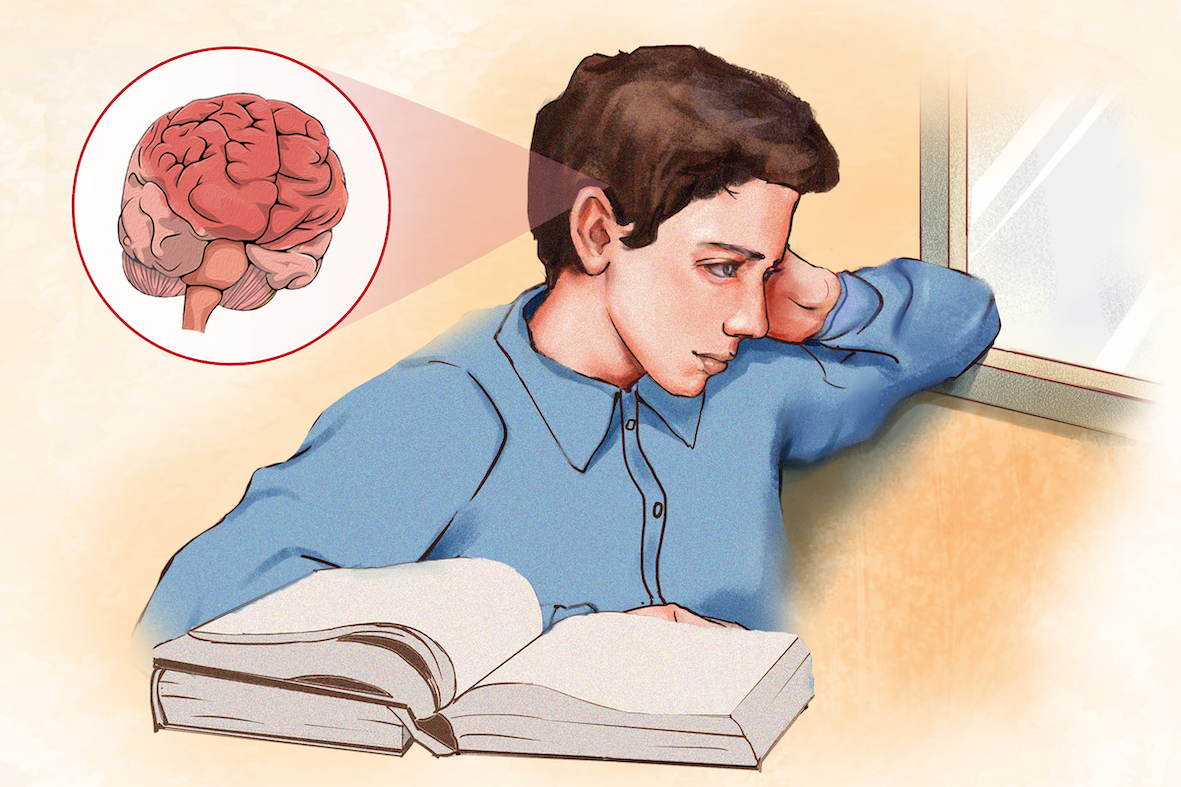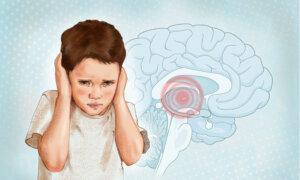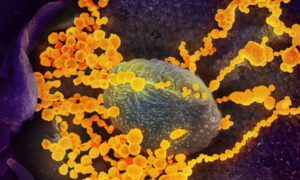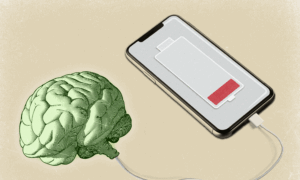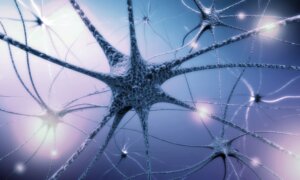Previously known as attention deficit disorder (ADD), attention-deficit/hyperactivity disorder (ADHD) is characterized by a persistent pattern of inattention or hyperactivity-impulsivity that disrupts functioning or development. It is a neurodevelopmental disorder, a brain condition, and one of the most common childhood disorders.
Some evidence suggests that ADHD is more prevalent in the United States than in other developed countries. According to the 2018/2019 National Survey of Children’s Health (NSCH), 8.7 percent (5.3 million) of American children aged 3 to 17 years were estimated to have been diagnosed with ADHD.
Around one-third of children diagnosed with this condition retain the diagnosis into adulthood.

Influenced by genetics and environmental factors, changes in the brain, including size and maturation, are implicated in the development of ADHD. (Illustration by The Epoch Times, Shutterstock)
According to the Diagnostic and Statistical Manual of Mental Disorders, Fifth Edition (DSM-5), there are three forms of ADHD. They are:
- Inattentive: A child with this type primarily experiences inattention and is easily distracted. This subtype is more common among females.
- Impulsive/hyperactive: This is the rarest form of ADHD. A child with this type is impulsive and hyperactive but does not have difficulty paying attention. They may perform excessive movement inappropriate for the setting and take hasty actions without thinking. They also struggle to organize or complete tasks and may find it difficult to follow instructions or conversations. They may also fidget or talk excessively.
- Combined: This is the most prevalent form of ADHD. A child with this type is both impulsive and hyperactive. They also struggle with maintaining focus and are easily distracted.
ADHD symptoms usually emerge in early childhood, with many parents noticing excessive motor activity in toddlers. However, distinguishing these symptoms from typical impulsivity, inattentiveness, and active behavior in children under 4 can be challenging.
Symptoms in Children
ADHD symptoms can manifest as early as ages 3 to 6. The different types of ADHD symptoms include those listed below.
Inattentive symptoms:
- Failure to pay attention to details or making careless mistakes at school
- Struggling to maintain focus during tasks or play
- Demonstrating an age-inappropriate brief attention span
- Not listening when spoken to directly
- Failure to follow through on instructions and not completing schoolwork or chores
- Experiencing difficulty in organizing tasks and activities
- Overlooking or missing details
- Avoiding or disliking tasks that require sustained mental effort, such as schoolwork
- Exhibiting poor organizational and study skills for their age
- Frequently losing items such as homework and school supplies
- Being easily distracted
- Being forgetful
- Frequently shifting from one task to another without finishing any
Hyperactivity symptoms:
- Appearing constantly in motion, without a clear purpose other than movement
- Being restless, fidgeting, or squirming in their seat
- Frequently leaving their seat when expected to stay seated
- Running around or climbing inappropriately
- Having difficulty playing or working quietly
- Talking excessively
Impulsivity symptoms:
- Interrupting or blurting out answers before questions are finished
- Having difficulty waiting for their turn
- Often interrupting or intruding on others in conversations or activities
- Frequently engaging in risky behavior, often without prior thought or consideration
- Getting upset easily
Many of these behaviors are typical during childhood development. These behaviors must exceed what is considered normal for a person’s age and developmental stage for ADHD to be diagnosed.
Children with ADHD frequently encounter challenges in achieving independent functioning and may display behaviors that are younger than their peers. Additionally, many children with ADHD may experience mild delays in language, motor skills, or social development, which often occur alongside ADHD but are separate conditions.
Approximately 20 percent to 60 percent of children with ADHD experience learning disabilities that affect reading, math, or written language, often leading to academic difficulties such as poor grades. Around 60 percent of children throw temper tantrums, while most older children exhibit low tolerance for frustration. These difficulties can contribute to issues with self-esteem, depression, anxiety, or defiance toward authority by adolescents. Many adolescents with ADHD also face challenges in relationships and may exhibit antisocial behaviors.
ADHD symptoms can also change over time and may intensify with increased daily life demands, thus evolving in their presentation over the years.
Symptoms in Adults
ADHD is typically recognized in childhood, but it may not be diagnosed until adolescence or adulthood. The symptoms include:
- Difficulty concentrating: Individuals with ADHD can often focus well on activities they find enjoyable; however, they struggle to maintain focus on tasks perceived to be mundane, boring, or repetitive, regardless of their efforts.
- Hyperfocus: Hyperfocus is a tendency to become deeply immersed in stimulating and rewarding tasks to the extent that one becomes unaware of one’s surroundings.
- Poor executive functioning.
- Persistent tardiness.
- Habit of procrastinating.
- Restlessness.
- Mood swings.
- Weak self-discipline; prone to addiction.
- Impatience.
- Challenges with maintaining relationships.
- Easily becoming flustered and stressed.
- Low self-esteem and feelings of insecurity or underachievement.
- Difficulty maintaining motivation.
- Highly sensitive to criticism.
Women often go undiagnosed or misdiagnosed with ADHD because their symptoms, typically inattentiveness rather than hyperactivity or impulsiveness, differ from those in men. Women tend to hide these symptoms better, using coping mechanisms to manage poor organization or time-management skills, which complicates diagnosis. Without a diagnosis, women may struggle with organization, self-doubt, low self-esteem, and confidence issues. Additionally, they are more prone to anxiety and depression.
ADHD appears to have multiple causes, including genetics, brain abnormalities, and environmental factors. These factors combine to cause the condition with a wide range of symptoms.
1. Genetics
Research shows that ADHD is highly hereditary and influenced by dozens of genes critical for brain development and the functioning of brain chemicals. Most people with ADHD have many gene variations, each with a small effect. These genetic variations, combined with environmental risk factors, contribute to an individual’s overall risk of developing ADHD. In rare cases, ADHD is caused by unique gene mutations or chromosomal abnormalities. Usually, a mutation in just one gene is enough to cause ADHD in these individuals.
2. Brain Abnormalities
Noninherited neurological factors that influence brain development and brain injuries have been linked to the development of ADHD. Children with the condition have lower levels of the brain chemical dopamine, which plays a crucial role in various essential functions, including cognition, motivation, behavior, and movement control. Research shows that these people’s parts of the brain responsible for attention, social judgment, and movement also have lower metabolism.
Differences have also been observed in the structural development and activity of the prefrontal cortex, basal ganglia, anterior cingulate cortex, and cerebellum. Conditions such as brain injury from lack of oxygen, epilepsy, and traumatic brain injuries can also increase the risk of developing ADHD.
Overall, the brain of a child with ADHD develops normally, but the process, especially in the frontal lobe, tends to be slower compared to children without it.
3. Environmental Factors
The following factors may influence the development of ADHD:
- Maternal smoking during pregnancy: However, new evidence is beginning to challenge this belief.
- Maternal alcohol consumption during pregnancy.
- Premature birth.
- Low birth weight of less than 3 pounds (1,500 grams)
- Exposures to alcohol, tobacco, or possibly cocaine before birth.
- Brain injury.
- Poor parental mental health: A 2024 meta-analysis found that maternal stress, anxiety, and depression, postpartum depression, and paternal depression had all been positively linked to ADHD in children.
- Exposure to toxins: Examples include lead, organophosphate pesticides, and polychlorinated biphenyls (PCBs).
- A high-conflict home environment.
- Early childhood trauma: Most children with ADHD have not experienced early trauma, but some have suffered from violence, abuse, or neglect.
- Nutrient deficiency: A 2004 study involving 53 children with ADHD suggested that low iron levels may contribute to ADHD. Deficiencies in zinc, magnesium, and vitamin D have also been reported.
The following factors raise one’s risk of developing ADHD:
- Sex: According to the NSCH, ADHD diagnosis is consistently more prevalent in boys than girls. Among adolescents, 13 percent of males and 4.2 percent of females are affected. Among adults, 5.4 percent of males and 3.2 percent of females are affected.
- Race: Among adults, the non-Hispanic white group had the highest prevalence of 5.4 percent compared to all other race and ethnicity groups. Among adolescents, the non-Hispanic black group had the highest prevalence of 9.3 percent.
- Family history: ADHD often runs in families, with many parents of children with ADHD having had symptoms themselves during childhood. The condition frequently appears in siblings. A 2017 study involving over 1.6 million young people—among whom nearly 32,000 were diagnosed with ADHD—found that siblings of those with ADHD are almost nine times more likely to have ADHD compared to siblings of people without the disorder.
- Traumatic brain injuries.
- Toxin exposure before birth or in childhood.
- Obstructive sleep apnea (OSA): People with OSA often have trouble paying attention, with up to 95 percent of them experiencing this issue. Among people with full ADHD, 20 percent to 30 percent also have OSA. As per a 2011 review of six interventional studies, OSA might make ADHD symptoms worse for some people who are diagnosed with ADHD, and treating OSA may help improve ADHD symptoms.
ADHD is diagnosed based on clinical evaluation, as there are no specific lab tests or imaging results that can confirm it. In the case of a child suspected of having ADHD, parents and teachers are often involved in the evaluation process.
Some conditions, such as mood disorders, sleep problems, and oppositional defiant disorder, share the same or similar symptoms with ADHD, and they can be its comorbidities. When diagnosing ADHD, the doctor must rule out these conditions.
Diagnosis in Children
The
DSM-5 diagnostic criteria for ADHD include nine symptoms of inattention and nine symptoms of hyperactivity and impulsivity. A child must exhibit at least six symptoms from one or both groups to qualify for a diagnosis. Additionally, the symptoms must:
- Be present frequently for at least six months
- Be more severe than what is typical for the individual’s developmental stage
- Occur in at least two different settings, such as home and school
- Be evident before the age of 12
- Interfere with functioning at home, school, or work
Please consult the symptoms and early signs section for a list of inattention and hyperactivity and impulsivity symptoms.
The Vanderbilt ADHD Diagnostic Rating Scale (VADRS) is a tool for health care professionals to assess and diagnose ADHD in children and adolescents. It collects information from parents and teachers about the child’s behavior and symptoms, helps determine the severity of ADHD, and tracks progress.
The Conners Comprehensive Behavior Rating Scales (Conners CBRS) is a set of standardized tools used to evaluate behavioral, emotional, social, and academic issues in children and adolescents. These scales help in identifying and diagnosing various conditions, including ADHD.
Diagnosis in Adults
In adults, the core symptoms seen in children and adolescents may be absent and instead present as issues such as procrastination, mood instability, and low self-esteem. Adults are more likely to exhibit impulsivity or inattention, as they tend to have better control over hyperactivity symptoms. Some adults with ADHD remain undiagnosed.
Adults are diagnosed with ADHD if:
- They typically exhibited several ADHD symptoms before age 12
- As adults, they experience at least five persistent ADHD symptoms listed according to the DSM-5 diagnostic criteria
- Their ADHD symptoms are present in two or more settings and interfere with or reduce the quality of social, school, or work functioning
A thorough evaluation of adult ADHD also involves reviewing childhood behavior and school experiences. With permission, the health providers may interview a potential patient’s family members, friends, and acquaintances. They may also use standardized behavior rating scales (e.g.,
Brown Attention Deficit Disorder Scale) or ADHD symptom checklists to assess whether the adult meets the diagnostic criteria. Psychological tests may be administered to evaluate working memory, executive functioning, visual and spatial skills, and reasoning abilities to detect or rule out learning disabilities.
Symptom Severity
The DSM-5 requires professionals diagnosing ADHD to specify the severity of the disorder, as symptoms affect individuals to varying degrees. There are three levels of severity, including:
- Mild: The disorder causes minor impairment in social, school, or work settings.
- Moderate: Symptoms or functional impairments fall between “mild” and “severe.”
- Severe: There are numerous symptoms of ADHD, with several being particularly severe, resulting in significant impairment in social, school, or work settings.
As people grow older, ADHD symptoms may decrease, evolve, or appear differently. Adults who still exhibit some symptoms from childhood ADHD, though not all, can be diagnosed with ADHD in partial remission.
The following are possible complications of ADHD:
- Parent-child conflict
- Other mental health conditions, like depression and anxiety
- Substance abuse
- Poor academic performance
- Frequent job-hopping
- Trouble with the law
- Suicide: According to a 2013 study, people with ADHD have a higher risk of dying by suicide compared to those without ADHD.
- Difficulty with relationships, causing loneliness
- Increased car accidents
- Poor executive skills
- Low self-esteem
Although ADHD cannot be cured, it can be effectively managed by several types of treatment. Usually, doctors recommend different treatment options based on a patient’s age, such as:
- Preschoolers: It is recommended that parents be provided with training in behavioral management before considering medication.
- Children aged 6 and above: Combining behavioral management with medication treatment is recommended.
- Adults: Medication is a key component in treating adults with ADHD.
Generally, half of patients “grow out of” ADHD with treatment, and another 25 percent no longer require treatment as adults.
1. Behavioral Management
Behavioral treatment should begin as soon as a child receives a diagnosis, or even if the diagnosis is uncertain. Early intervention, before bad habits develop, is beneficial. Many techniques can be used to help manage behaviors, such as:
- Counseling.
- Cognitive behavioral therapy (CBT): CBT may include goal-setting, modeling, and role-playing. Structure and routines are crucial.
- Classroom behavior management: Classroom behaviors can be improved by controlling noise and visual stimulation, adjusting task length, introducing novelty, providing coaching, and ensuring teacher proximity.
- Incentives and token rewards: Incentives can reinforce and enhance behavior management.
- Parent-child interaction therapy: This therapy involves both the parent and child, where the parent learns strategies to encourage positive behavior.
- Social skills training.
Key points for behavior management include setting achievable goals in small steps, maintaining consistency across times, settings, and individuals, applying consequences immediately after behavior, and using behavioral interventions consistently over the long term.
2. Medication
ADHD medications can be used alone or in combination. A health care provider will determine the appropriate medication based on the individual’s symptoms and needs. The most commonly used ADHD medicines include:
- Psychostimulants: Also called stimulants, psychostimulants have a calming effect and are commonly used to treat ADHD. They may help individuals focus, concentrate, and manage impulses. Responses to these medications vary, and dosages depend on behavior severity and individual tolerance. Examples include methylphenidate and dextroamphetamine.
- Selective norepinephrine reuptake inhibitors (SNRIs): Atomoxetine is an SNRI shown to be effective in improving ADHD symptoms in adults. Another example is venlafaxine.
- Others: When stimulants don’t work well or cause too many side effects, doctors sometimes use other types of medications, such as alpha-2 agonists (e.g., clonidine and guanfacine) and other psychoactive drugs. However, these alternatives are generally less effective and are not usually the first choice for treatment.
Tips for Parents
Tips for parents include:
- Communicating regularly with the child’s teacher
- Establishing and following a consistent daily routine for homework, meals, and activities and notifying the child of any changes in advance
- Minimizing environmental distractions
- Providing a healthy diet rich in fiber and essential nutrients and excluding processed foods
- Ensuring adequate sleep
- Reinforcing the child’s positive behavior with praise and rewards
- Setting clear and consistent rules for the child
- Celebrating every success, whether big or small
- Breaking tasks into smaller steps
- Using visual reminders like lists, charts, or notes for schedules and tasks
- Taking time to listen to the child, as children with ADHD may struggle to express their thoughts and feelings
- Receiving parental skills training to develop skills (e.g., giving positive feedback) that will help the child
Self-Help for Adults
The following are tips for managing ADHD as an adult:
- Exercise and eat healthy: Limit sugary items to help stabilize mood swings.
- Get enough sleep.
- Practice better time management: Set deadlines for all tasks, including small ones, and regularly use tools such as alarm clocks.
- Work on your relationships.
- Create a supportive work environment: To enhance productivity, use tools such as lists, color coding, reminders, notes, and organized files.
Mindset significantly affects the management of ADHD by influencing various aspects of an individual’s approach to their condition and overall well-being.
A positive mindset fosters self-perception and confidence. It also encourages individuals to believe in their ability to manage ADHD effectively and learn new life skills. This belief can boost self-esteem and motivation, leading to active engagement in strategies to cope with ADHD and persistence through difficulties.
Cultivating a growth mindset can propel you forward. This type of mindset enables you to learn and grow as an individual. The approach contrasts with a fixed mindset, where believing that ADHD is unchangeable can limit efforts to seek solutions. Some individuals with ADHD tend to adopt an all-or-nothing mindset when dealing with social situations or tasks, which is detrimental to their relationships. A constructive mindset improves a person’s interpersonal skills and relationships by viewing social challenges as growth opportunities.
Behavioral management is also affected by mindset. A proactive approach involves actively seeking out and implementing behavioral management techniques to mitigate ADHD symptoms.
Several natural methods are available to treat ADHD, but scientific evidence for their effectiveness is often limited. Therefore, it’s essential to consult your doctor before trying any of these approaches.
1. Medicinal Herbs
- Passionflower (Passiflora incarnata): Passionflower is native to the southeastern United States and Central and South America. It is used to treat anxiety and insomnia in some parts of the world. Scientists believe it works by increasing levels of gamma-aminobutyric acid (GABA) in the brain, which reduces the activity of certain brain cells and promotes relaxation. A 2005 study found that an eight-week trial with passionflower tablets yielded results similar to methylphenidate treatment, with no serious side effects recorded.
- French maritime pine bark (Pinus pinaster): Pycnogenol is an extract from the bark of the French maritime pine and contains phenolic acids, catechin, taxifolin, and procyanidins. A 2006 randomized controlled trial (RCT) involving 61 children with ADHD showed that a four-week administration of Pycnogenol significantly reduced hyperactivity and improved attention, visual-motor coordination, and concentration in the participants. Another 2006 RCT found that a one-month treatment with Pycnogenol improved attention in children with ADHD, reduced oxidative DNA damage, and normalized antioxidant levels.
- Ginseng (Panax ginseng): Ginseng has neuroprotective properties and has been found to improve ADHD symptoms. The results of a 2014 study suggested that Korean red ginseng extract could be an effective and safe alternative treatment for children with ADHD.
- Saffron (Crocus sativus): A 2021 study found that combining methylphenidate with saffron was more effective in treating ADHD patients than using methylphenidate alone.
- Sweet almond (Prunus dulcis): The results of a 2019 study indicated that both methylphenidate and sweet almond syrup treatments were equally effective in reducing symptoms in children with ADHD.
- Bacopa (Bacopa monnieri): A study published in 2014 showed that bacopa, an Ayurvedic medicine also sometimes called Brahmi, could significantly improve ADHD symptoms.
2. Dietary Supplements
- L-theanine: A 2011 study found the amino acid L-theanine safe and effective in enhancing certain aspects of sleep quality in boys diagnosed with ADHD. A 2019 study involving five children with ADHD found that the combination of L-theanine and caffeine could improve attention span and reduce mind wandering.
- Nutrients: Some patients with ADHD suffer from deficiencies in essential nutrients such as B vitamins, vitamin D, magnesium, zinc, and iron. For these patients, supplementing these nutrients may improve their ADHD symptoms. For instance, a 2006 study found that a magnesium-vitamin B6 regimen significantly improved ADHD symptoms in 40 children. A 2021 meta-analysis found that zinc supplementation could lead to a significant reduction of ADHD symptoms. Iron supplementation has also been found to be effective among ADHD patients with iron deficiency, but it is not the case with children without it.
- Gamma-aminobutyric acid (GABA): Evidence also suggests that among ADHD patients, there may be a problem with the brain’s ability to regulate itself properly due to a deficiency of the calming amino acid GABA. Long-term use of one GABA supplement has been found to reduce hyperactivity and improve attention in adults with borderline to mild intellectual disability and coexisting ADHD.
3. Elimination Diets
Elimination diets for ADHD patients involve removing specific foods or food groups from their diet to identify and reduce potential triggers for their symptoms. These triggers may be potential allergens (e.g., eggs) and artificial ingredients (e.g., food additives).
Research shows that while an elimination diet may not work for every child with ADHD, some may experience significant improvements.
4. Yoga and Meditation
Mindfulness training may be a helpful addition to standard ADHD treatments. A 2018
meta-analysis found that meditation-based therapies (including yoga) led to significant reductions in the combined subtype of ADHD’s core symptoms. However, the researchers expressed concerns about the methodologies used in these studies. A 2023 systematic
review found yoga and meditation to have positive impacts on many ADHD symptoms.
5. Interactive Metronome Training
Interactive Metronome (IM) is a brain training program designed to improve timing, attention, impulse control, coordination, and self-regulation. A 2017
study found that it effectively improved timing, attention, working memory, and processing speed in children with ADHD.
6. Neurofeedback
Neurofeedback, also known as EEG biofeedback, monitors electrical activity on the scalp to display real-time brain activity. Patients then work on controlling their brainwaves to retrain their brain’s function. The researchers of a 2009
meta-analysis concluded that neurofeedback treatment for ADHD is effective and targeted, showing a substantial impact on reducing inattention and impulsivity and a moderate impact on reducing hyperactivity.
7. Green Outdoor Activities
Children with ADHD who frequently play in
green, natural environments experience milder symptoms than those who play in constructed outdoor or indoor settings. A 2004
study found that green outdoor settings seem to reduce ADHD symptoms in children, regardless of their individual traits, residential circumstances, or case characteristics, although the study was criticized for
methodological limitations.
8. Reduced Screen Time
According to a cohort
study published in 2019, children who spent over two hours per day on screens had a 7.7 times higher risk of meeting the criteria for ADHD. Therefore, reducing screen time may be helpful to children with ADHD and possibly in preventing it.
Due to ADHD’s unclear cause, experts do not yet know how to prevent it. However, early detection and treatment can reduce a child’s symptoms and support normal development. Several strategies can minimize the risk of developing ADHD. If you are pregnant, ensuring you avoid toxins, alcohol, and smoking and receive prenatal care is vital. Other ways to reduce the risk of ADHD or manage symptoms include:
- Following a balanced, whole-food diet.
- Getting regular and sufficient sleep.
- Exercising regularly.
- Avoiding processed food: Certain food colors and additives have been linked to ADHD.
- Creating a structured environment and consistent routines.
- Minimizing distractions and clutter.
- Avoiding exposure to toxins.
- Fostering a loving and supportive home environment for children (if you have them).
- Treating medical conditions that may cause ADHD (e.g., iron deficiency).

